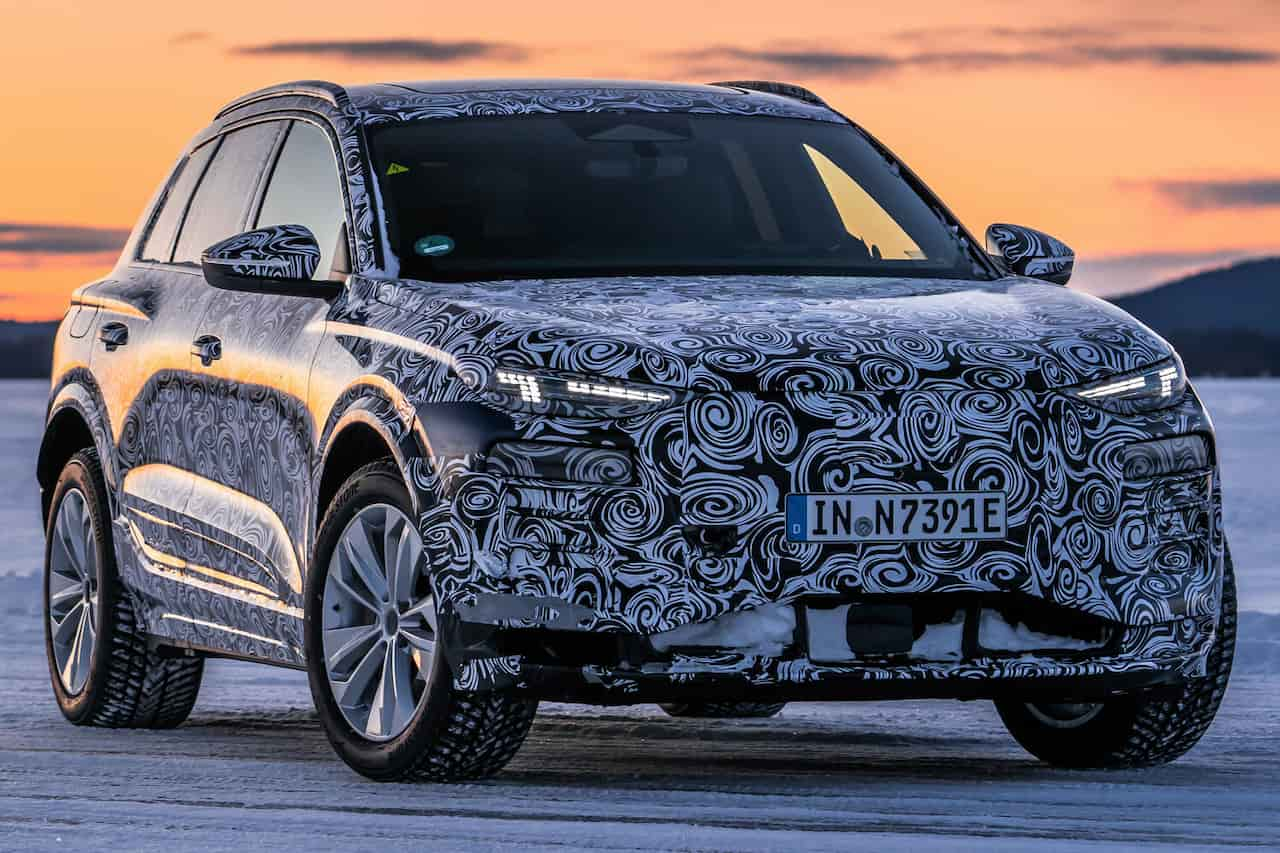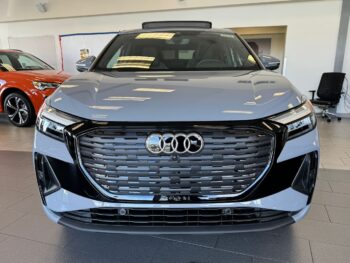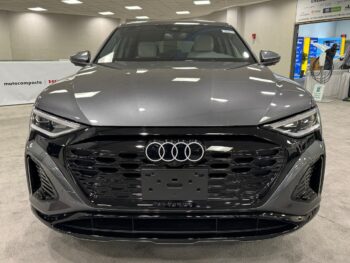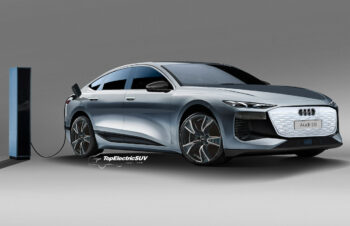Update: ‘Audi charging hub network’ sub-section of ‘Charging Network’ and ‘Release date’ section updated.
Audi plans to launch the ‘Q6 e-tron’ as a pure-electric alternative to the Q5, which is its best-selling model globally. The new Audi Q6 e-tron will be more advanced than the e-tron and Q8 e-tron, able to compete more effectively with the mid-sized models from around the world. Here’s everything we know about the Audi Q6 e-tron so far:
Design
Prototype shots suggest that the Audi Q6 e-tron could look like a bigger version of the Audi Q4 e-tron, just like the China-only Q5 e-tron that shares the MEB platform with the ID.6 SUV from the mainstream sister brand Volkswagen.
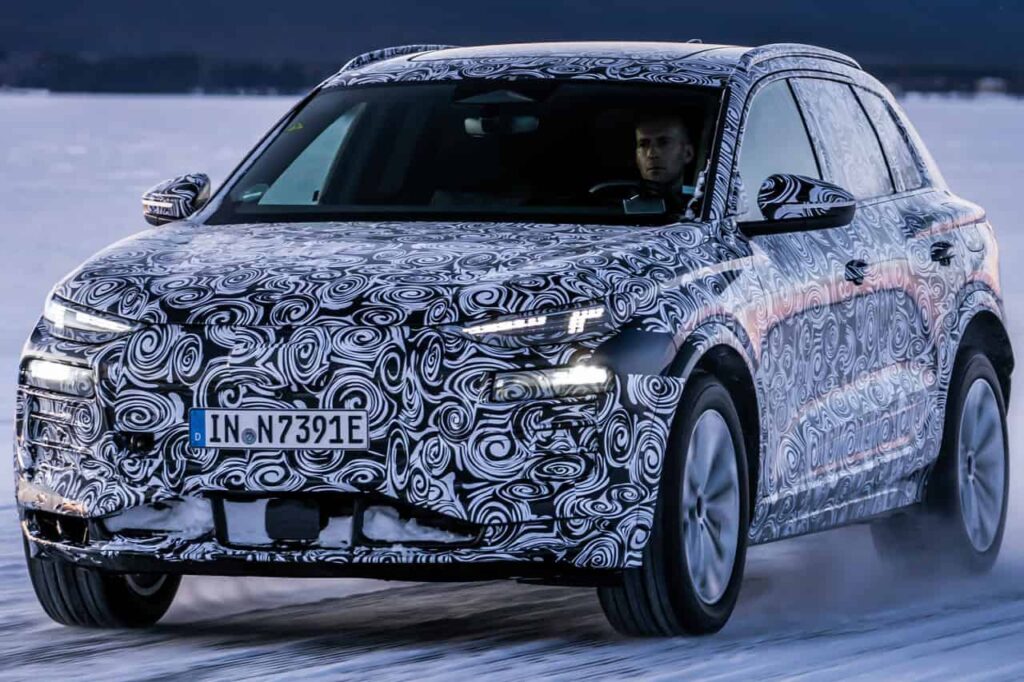
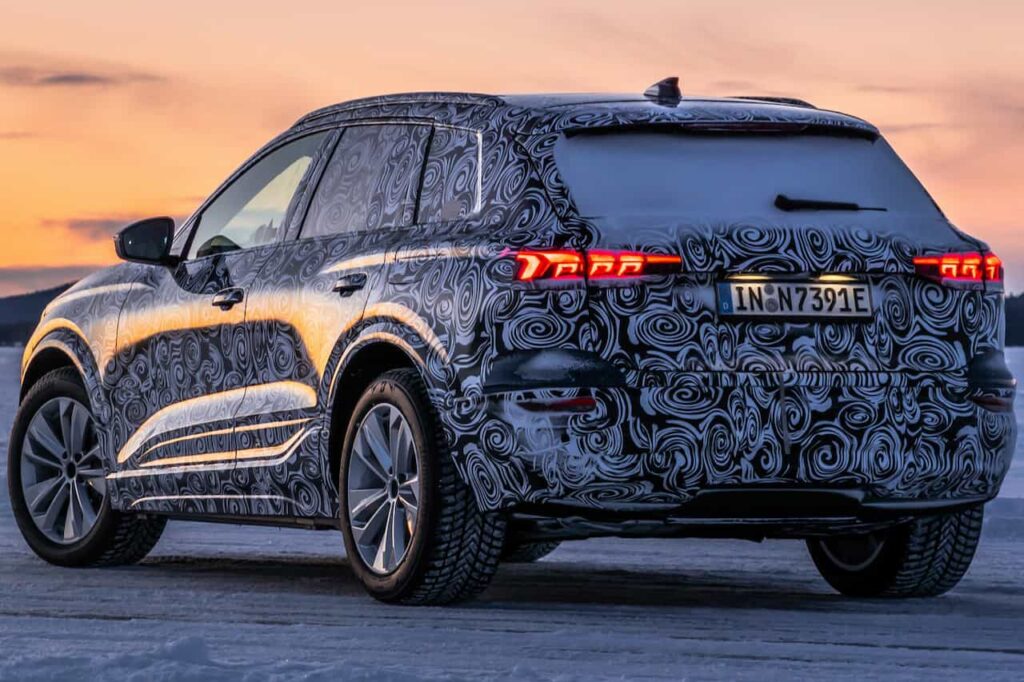
The Audi Q6 e-tron looks curvier than the e-tron/Q8 e-tron, which may make it look a wee bit softer. Pictures show a wider quarter glass size on the upcoming model, which means that rear-seat passengers will get a greater sense of space and more natural light.
The Q6 e-tron would feature a modern SUV design with an elegantly dominating front fascia, raked A-pillars, a swiftly sloping roofline, and a hunched rear section. Like the e-tron GT, a faux Singleframe would conceal many of the sensors for driver assistance systems at the front. Other highlights should include wedge-shaped slim Matrix LED headlights, a classic SUV-style straight beltline, and LED rear lights connected by a narrow light strip.
Split headlamps
The Q6 e-tron, unlike the present global Audi SUV models, features split headlamps. The lights are bifurcated into a wedge-shaped upper part and a separately positioned rectangular lower part. These could be Digital Matrix LED headlights that even allow projecting symbols on the road. A large enclosed Singleframe grille in silver sits between the headlights, and right below is a functional air intake, which could be for cooling the drivetrain, battery, and brakes. We also see that there’s no frunk in the Q6 e-tron.
Expect the Audi Q6 e-tron to feature Digital Matrix LED headlights with customizable light signatures, 22-inch wheels, and a wind-cheating silhouette that allows a very low drag coefficient of around 0.25 Cd.
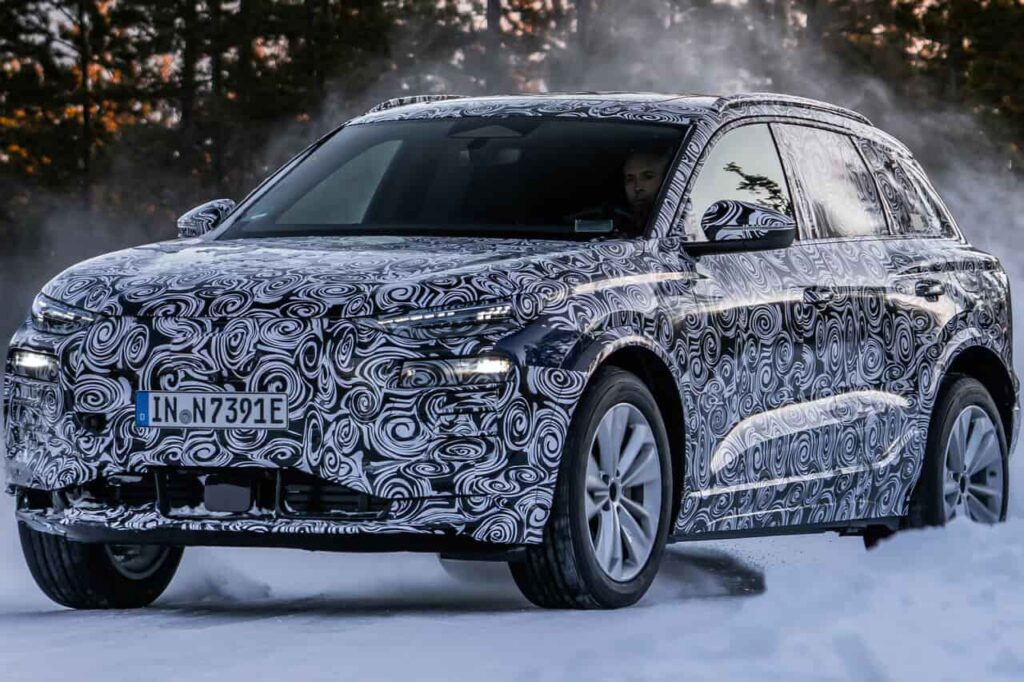
Audi Q6 Sportback e-tron
Road-testing of the Q6 Sportback e-tron, the Q6 e-tron’s SUV-coupe version, has also started. The sportier-looking model would have a softer roof that drops into steeply raked D-pillars. It would sit lower and will achieve a better drag coefficient value (possibly 0.25 Cd or lower). The better aerodynamics may allow a range longer by 5-8 miles (WLTP).
The coupe-style roofline of the Q6 Sportback e-tron would reduce headroom and cargo volume by up to 5 percent. In the e-tron’s case, the SUV version offers 39.8 inches of headroom in the front and 38.6 inches of headroom in the rear. The same dimensions of the Sportback version are 38.1 inches and 37.9 inches, respectively. Similarly, while the SUV offers a luggage capacity of 28.5 cubic feet (second-row seats up)/57.0 cubic feet (second-row seats down), the Sportback version offers a luggage space of 27.2 cubic feet (second-row seats up)/54.5 cubic feet (second-row seats down).
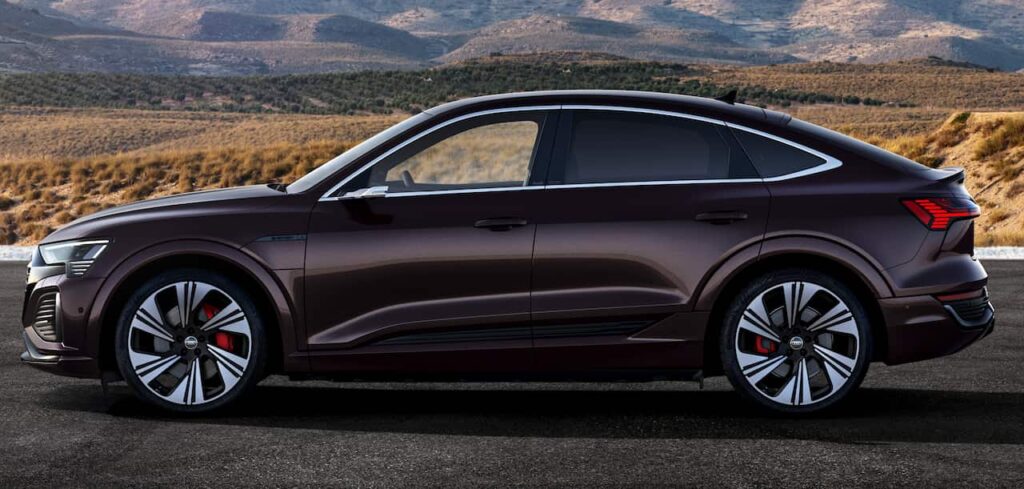
Long-wheelbase versions
According to a publicly issued Chinese government document, FAW-Audi will launch a Q6L e-tron, a Q6L e-tron Sportback, and an E6L Lim (Limousine) in China. We don’t understand the ‘L’ suffix in the names, but traditionally that has meant a long-wheelbase version. Audi offers most of its high-volume SUVs and sedans in China with a lengthened wheelbase. That tradition began with the A6 in 1999, as Chinese customers love the rear seat.
Specifications
PPE Architecture
The next-gen Porsche Macan and the Audi Q6 e-tron will ride on a new dedicated BEV platform called Premium Platform Electric (PPE) or ‘PPE-Architektur’ in German. Co-developed by Porsche and Audi, the PPE will underpin several future models for the two brands including the A6 e-tron, A6 e-tron Avant and the next-gen Porsche Cayenne.
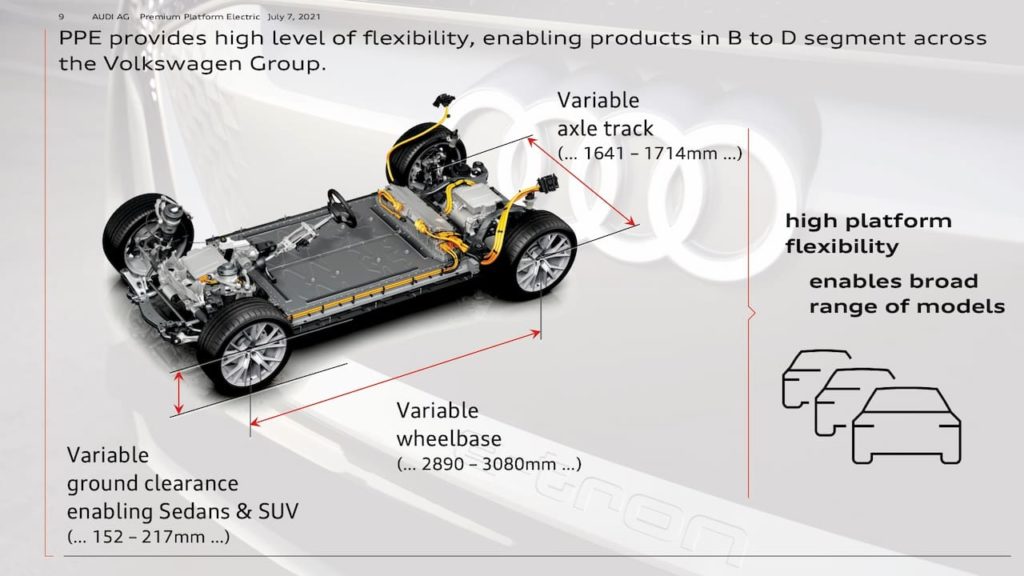
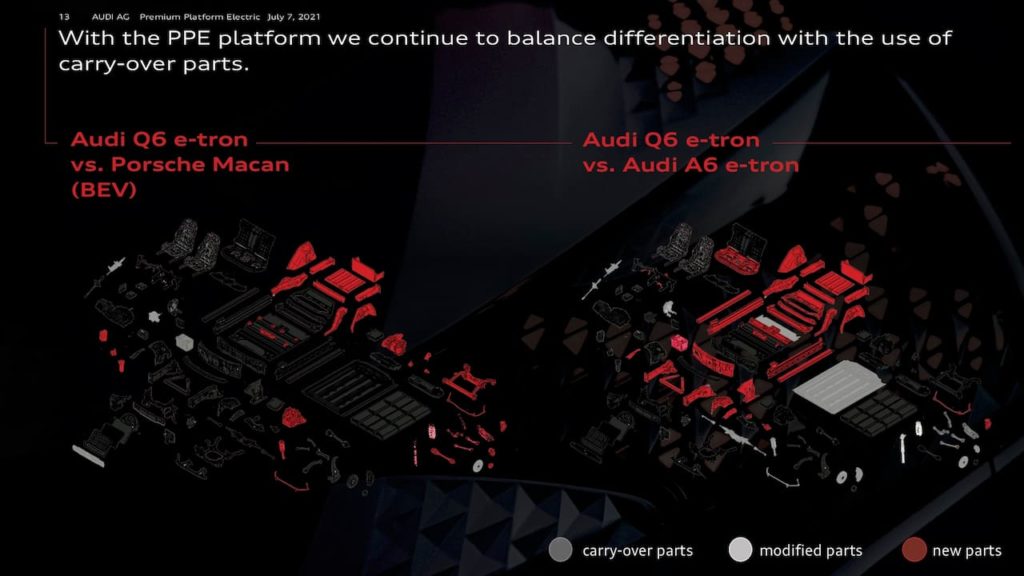
Space
Thanks to the dedicated EV platform, the Q6 e-tron will offer a highly spacious cabin. Audi has said that the low-floor PPE platform-based models will offer a greater interior length even with slightly shorter exterior dimensions and overhangs compared to MLB platform cars.
On September 26, 2022, citing a person familiar with developments at Audi, Autocar reported that the Q6 e-tron will be approximately the size of the Q5. However, thanks to its space-efficient dedicated EV platform, it will offer interior and cargo space similar to the Q7.
Audi has confirmed that the Q6 e-tron offers 18.6 cu. ft. of cargo space behind the second-row seats, which can be folded down individually (40:20:40). Folding down all the rear seats increases the cargo space to 54 cu. ft. The so-called frunk (front trunk) offers 2.3 cu. ft. of additional storage space, which customers can use to stow small things like a mobile charging cable or a gym bag.
Performance
Audi says that the PPE is similar to the MEB, but it allows greater performance parameters with higher output. A rear-mounted electric motor is standard, while high-end configurations can get a second electric motor (PSM or ASM) at the front axle for eAWD.
PPE platform underpinning the Audi Q6 e-tron means the model’s availability in rear-wheel drive and all-wheel drive configurations, with the latter featuring an additional motor mounted at the front. For now, we have confirmation of two variants of the Q6 e-tron: 55 and S.
Both Q6 55 e-tron and SQ6 e-tron use two motors and have an AWD drivetrain layout. The Q6 55 e-tron’s powertrain generates 375 hp, while the SQ6 e-tron develops 483 hp. A boost mode allows the driver to temporarily increase these numbers to 396 hp and 510 hp, respectively. A 0-60 mph sprint in the Q6 55 e-tron and SQ6 e-tron should take <6 seconds and <4.5 seconds, respectively.
Source: CarSpyMedia/Youtube
In an interview with auto motor und sport, which the German publication released in its magazine on April 20, 2023, Oliver Hoffmann, BoM member responsible for Technical Development, Audi, indicated that the Q6 e-tron will be available in RWD and AWD drivetrain layouts.
Asked whether the Q6 e-tron will be available in a RWD variant like the Q4 e-tron, Hoffmann said that Audi will certainly offer more entry-level models that are rear-wheel driven. If a model has an almost 50:50 weight distribution and a dynamic wheel load distribution, then RWD makes perfect sense, the R&D boss added. Most Q6 e-tron customers seeking maximum energy efficiency would opt for the RWD configuration. The U.S. may only get the AWD variants, at least initially.
Also Read: Audi SQ6 & Audi RS Q6 variants will top off the Q6 Electric line-up
Charging & range
The Audi Q6 e-tron has a battery pack with an energy storage capacity of around 100 kWh, comprising 12 modules consisting of 180 prismatic lithium-ion cells. This battery pack supports 800-volt chargers and has a peak charging input of 270 kW. A 10-80% charging session using a DC rapid charger takes less than 30 minutes. The Q6 55 e-tron may deliver an EPA-est. range of around 325 miles, while the SQ6 e-tron’s EPA-est. range could be around 300 miles.
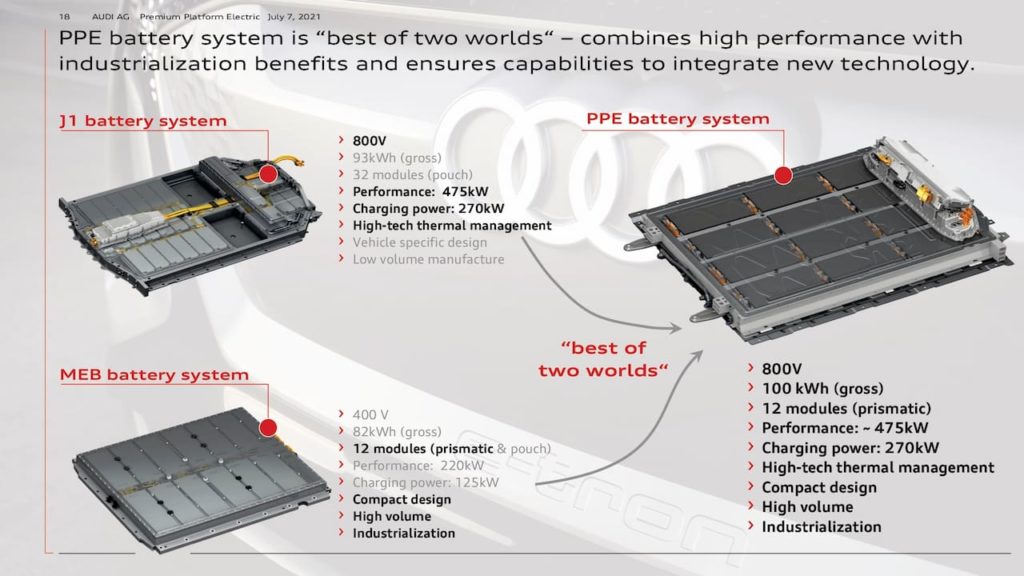
First impressions
Audi conducted a media drive of both variants of the Q6 e-tron with prototypes in the Faroe Islands recently, and the overall feedback is largely positive. Thanks to its air suspension, the ride is smooth and comfortable. The circa-100 kWh battery pack makes the Q6 e-tron heavy, but turning into corners is confidence-inspiring and fun. The new electric SUV handles well and offers plenty of grip.
The Q6 e-tron doesn’t feel as heavy as it actually is, as there’s plenty of power and torque available from the dual-motor powertrain. Even the 55 variant feels sufficiently quick, so most customers may not feel they need to upgrade to the sportier S variant. The steering could use some more feedback, though, especially in the S variant, which doesn’t feel like a significant upgrade from the 55 variant in this aspect.
Audi will likely continue refining the Q6 e-tron until its market launch and make changes to ensure customers drive and ride in the best possible version.
Interior & Features
Audi has confirmed that it is possible to package PPE models with a plethora of high-end features, including torque vectoring, all-wheel steering, and air suspension. It’s safe to assume that the Q6 e-tron will be its most comfortable electric SUV to date.
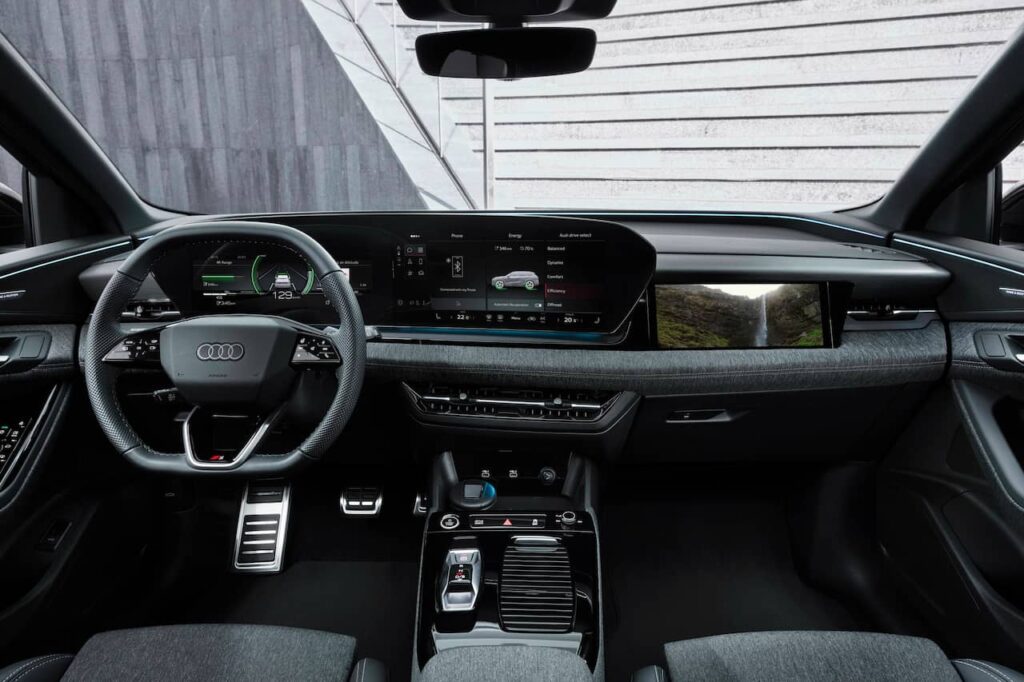
The Q6 e-tron’s interior looks more like an evolution from the current Audis than something radically new, and that’s a good thing. Customers switching from conventional models will find a sense of familiarity and easily acclimatize with various operations, things that new-age companies like Tesla are willfully ignoring with an over-emphasis in the name of minimalism. A so-called ‘Softwrap’ extends from the doors through the entire cockpit to the center console.
The dashboard has a concaved surface in the middle, and along with the three displays, slim outer-end AC vents, and compact central AC vents, and looks sleeker than that of the Q8 e-tron. It merges with the door panels in a way that makes the front occupants feel as if the interior wraps around them and gives them a sense of security. The center console is more practical and houses two cupholders, a smartphone charging tray, and two smartphone charging ports. There’s no center tunnel, thanks to the dedicated EV platform.
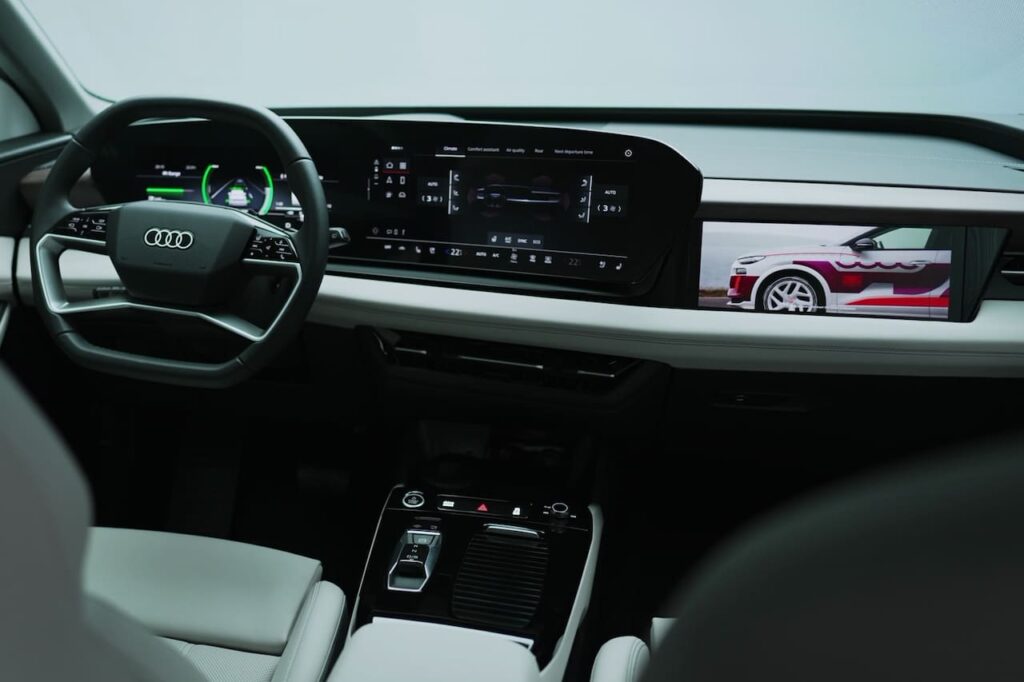
Innovative technology is one of the key attractions of Audis, particularly for young customers who increasingly prefer vehicles with heavily digitalized controls, plenty of comfort and connectivity features, and driver assistance functions. The Q6 e-tron is no exception. Free-standing central displays are the latest trend, and many automakers, including Audi, are switching to this format from dashboard-integrated panels.
The Q6 e-tron features an 11.9-inch Audi virtual cockpit, a 14.5-inch MMI touch display, and a 10.9-inch MMI front passenger display. Audi has designed the area within the driver’s reach as an arc. The company has integrated the 11.9- and 14.5-inch screens to make them look like one seamless panel. In addition to the Audi virtual cockpit, essential driving information is shown through an augmented reality head-up display (AR-HUD). The items projected by the AR-HUD appear as if they are floating up to 656 ft. away, and the driver can understand them without confusion or distraction.
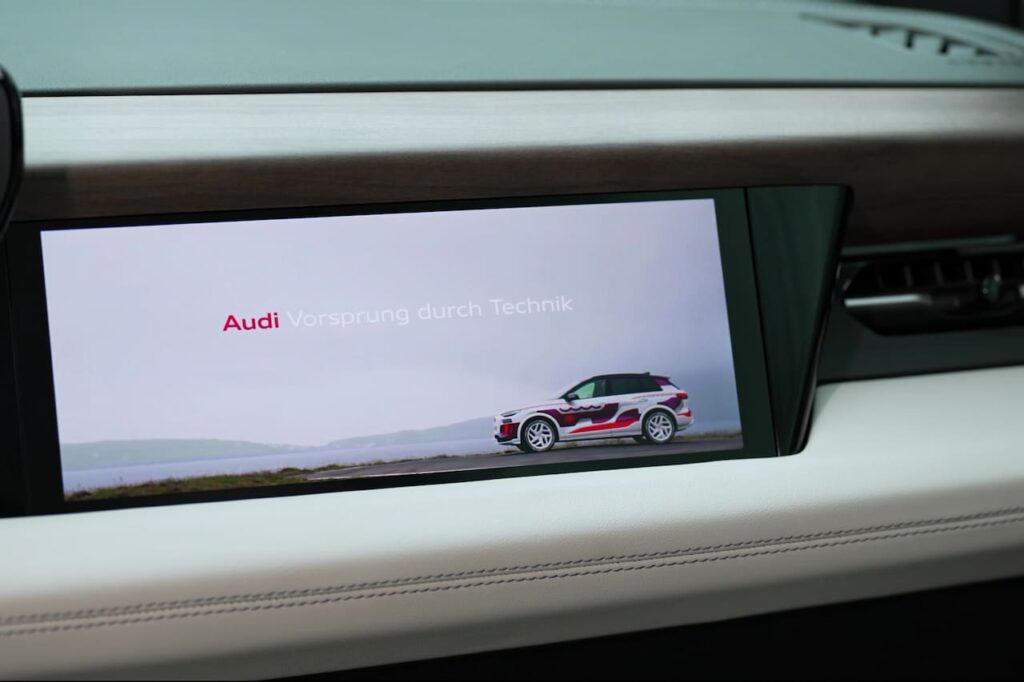
The 10.9-inch display allows the passenger to assist the driver, for example, with navigation. The passenger can also enjoy movies on the go. An active privacy mode with shutter technology ensures that the driver doesn’t get distracted by the media being played on this screen. While we’re on the subject of entertainment, it’s worth noting that the Q6 e-tron boasts an 830 W, 22-speaker B&O sound system.
Audi has equipped the Q6 e-tron with a new feature called ‘Interaction light (IAL),’ which works with the ambient light system consisting of LEDs that envelop the cockpit and the rest of the interior in an arc. The IAL greets the occupants, for example, with a welcome function. It merges into the contour light so that if it is inactive, it appears in the same color. It also enhances safety, for example, by visualizing the dynamic turn signals. It can also show the charge level and charging process with a pulsating light.
OTA-enabled features
Audi offers current models with both optional features and feature packages. However, beginning with the PPE platform models, the company plans to transition from single option to optional packages. As a result, expect fewer single options for customers to pick from on the Q6 e-tron. The Q6 e-tron will probably be hardware-ready for many features right from the basic trims, giving customers the flexibility to enable them anytime during their ownership. Customers could buy these optional features permanently by paying for them in full or for a limited period by paying a lower price.
E³ 1.2 software
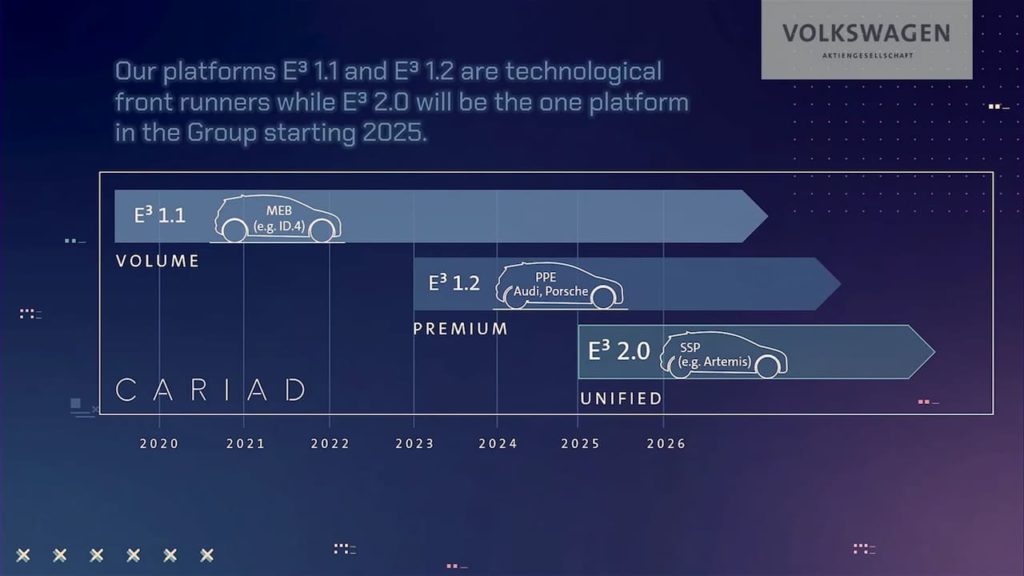
Volkswagen Group confirmed during the New Auto strategy announcement on July 13, 2021, that the Audi Q6 e-tron will feature a new-generation infotainment system based on Google’s Android Automotive. However, this infotainment system will have a third-party app store, not Google’s Play Store.
In 2023, CARIAD will release the premium software stack 1.2 with launches of the electric Porsche Macan and the Audi Q6 e-tron. It will bring a completely new experience to Audi and Porsche vehicles. This platform will feature a new unified infotainment platform based on Android Automotive and the third-party app store, providing you of the access to your favorite entertainment and messaging apps. With 1.2, the first vehicles will be ready to migrate to the all-new Volkswagen Automotive Cloud.
Dirk Hilgenberg, former CEO, CARIAD (Volkswagen Group New Auto strategy)
A report from mobiFlip, a German publication that spoke to the company after the event, suggests that it does not want this infotainment system to have any visible references to Google. It will use the AOSP (Android Open Source Project) version of the Android Automotive OS, which is license-free but excludes the Play Store. The Porsche Macan Electric will also get an infotainment system with Android Automotive OS-based software. However, the interfaces on both systems could look almost entirely different.
In an interview with Handelsblatt in January 2023, Volkswagen Group CEO Oliver Blume said that the Audi Q6 e-tron is as good as ready for series production, but it has software issues, and a team tests it on a daily basis. The E3 1.2 software simultaneously displays a wide range of applications and services on different screens, and its response time is comparable to that of a tablet’s software, Blume added.
During Volkswagen Group’s Q1 2022 investor and analyst conference call in May 2022 (listen on YouTube), former CEO Dr. Herbert Diess had said that E3 1.2 is “hugely complex,” more than E3 1.1 was. He said that E3 1.2 will continue to be a challenge in the next months.
It’s (E3 1.2 is) more complex than 1.1 was, far more complex, but I can tell you that the teams are really focused on the launches and we are confident that we can launch the cars as planned next years.
Dr. Herbert Diess, former CEO, Volkswagen Group (Investor and Analyst Conference Call Q1 2022 on May 4, 2022)
Steering wheel
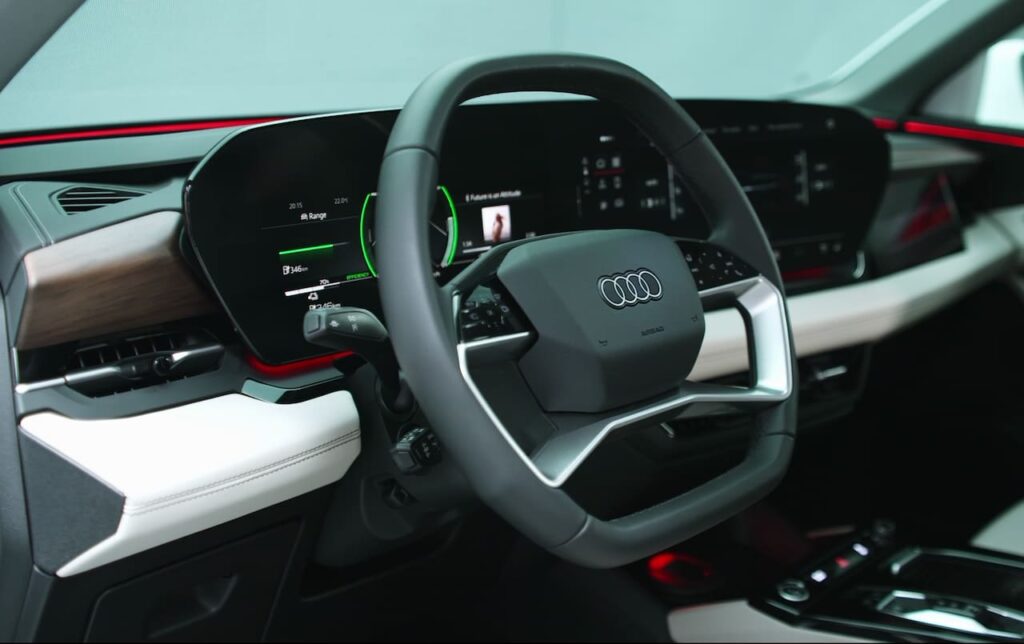
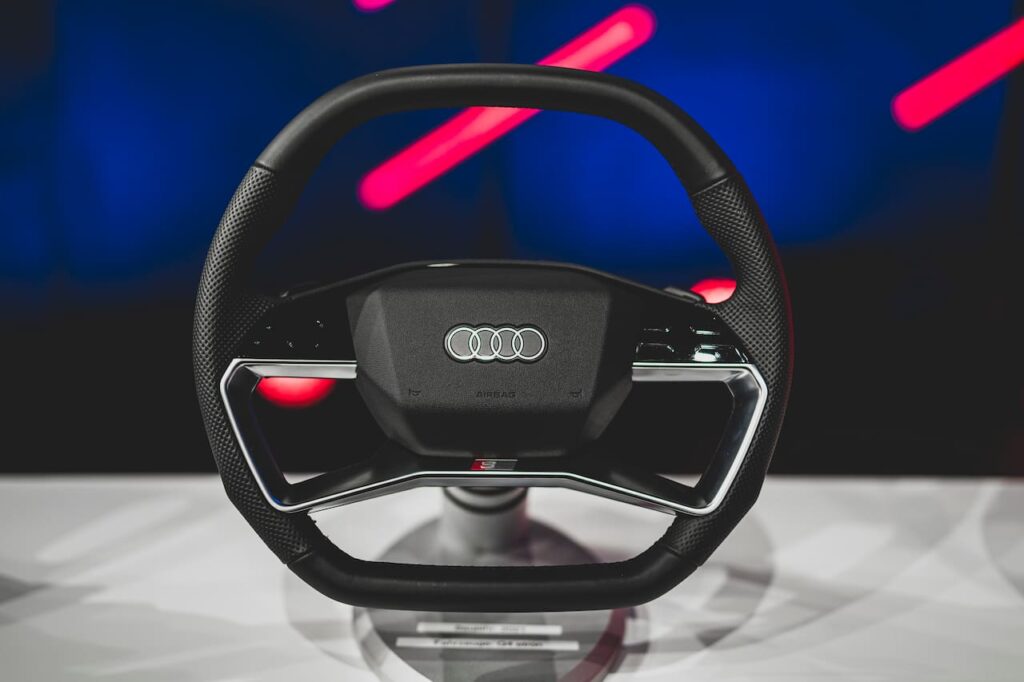
Audi has used an all-new steering wheel in the Q6 e-tron. It has a flattened top and bottom for a more futuristic effect, better ingress and egress, and improved road visibility.
The new-generation Audi steering wheel has high-gloss black touch screens instead of physical buttons. When inactive, they’d be virtually invisible. Small bumps forming an outline would let the driver feel the buttons without having to take their eyes off the road. The four interlocking rings on the impact absorber (center pad) have a flat, 2D design. The driver will likely be able to perform 18 different functions from the steering wheel.
Charging Network
Audi is building a High Power Charging network consisting of Audi charging hubs to support its EV offensive as luxury car owners demand a premium sales and ownership experience. The company is developing special charging stations to woo its EV customers.
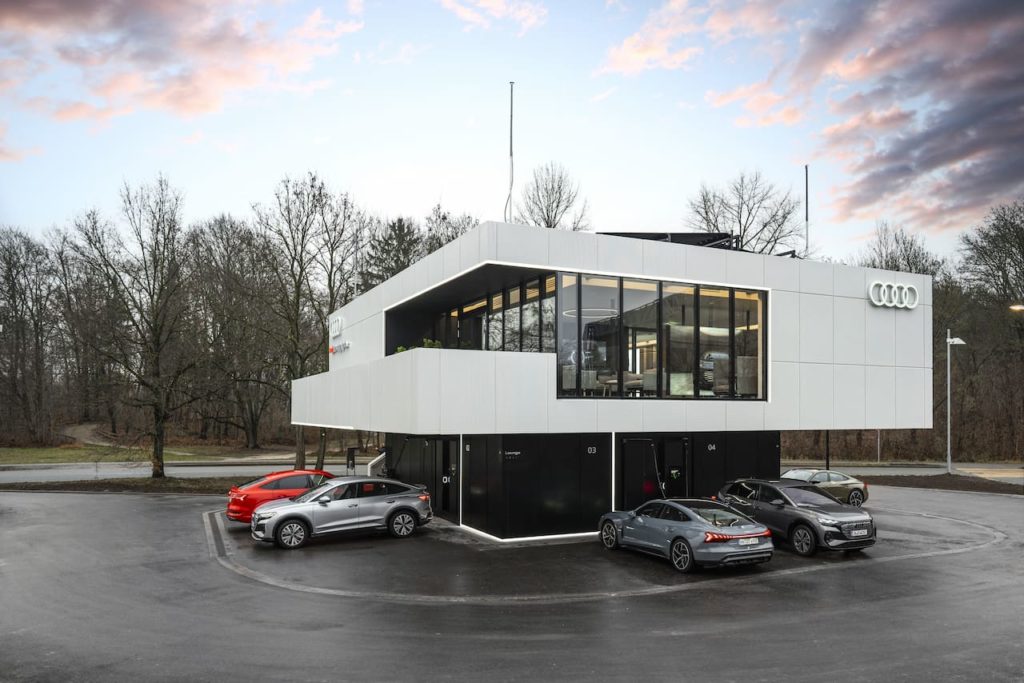
Audi EV customers can reserve their charging spot in advance and comfortably relax in a nearby lounge area while their EV charges up. With up to 320 kW of charging output available, it would take a little longer than a coffee break to prepare the Audi electric car for the rest of the trip. The e-tron GT, for example, can accept charging at up to 270 kW, taking roughly 23 minutes to charge the car’s battery from 5 to 80%.
Audi charging hub network
The first Audi charging hub opened at the Nuremberg Exhibition Center in Germany in December 2021. Audi makes the charging hubs with flexible container cubes, and it can get these assembled and disassembled in a few days. The company employs used and processed lithium-ion batteries to store energy for charging the EVs. These are second-life batteries coming from dismantled development vehicles.
At the Audi Annual Media Conference 2022, former CEO Markus Duesmann said that the pilot in Nuremberg was a very successful start. Audi has seen more than 2,000 charging sessions since December 2021, and customers are using all the available slots at the site, the CEO said. With this concept, the company is extending the usage of its EV battery packs and also reducing the load on the grid. At the beginning of November 2022, the company opened its second charging hub in Zurich, with four charging terminals that offer high-power chargers with a maximum power output of 320 kW.
In April 2023, Audi opened its third charging hub in Berlin (Germany), the second such charging station in its home market. In June 2023, the company opened Austria’s first Audi charging hub, located in Salzburg. Later, Munich became the fifth Audi charging hub destination in Europe—the third in Germany—in September 2023.
Plug & Charge
European Q6 e-tron customers will benefit from IONITY’s widespread and ever-expanding EV charging network. IONITY, a joint venture between BMW Group, Ford, Hyundai Motor Group, Mercedes-Benz, and Volkswagen Group, plans to invest around EUR 700 million to open more than 5,000 fast-charging points in Europe by 2025. It will install EV chargers offering DC charging at up to 350 kW in more than 1,000 locations. Currently, IONITY has 2,138 high-power chargers in 462 locations in Europe.
Audi now offers a Plug & Charge feature in its EVs, but exclusively on the IONITY network. Customers don’t need to authenticate with an RFID card or an app. The company will likely offer plug & charge feature in the Q6 e-tron right from launch, perhaps even in North America.
Manufacturing
Production of the Q6 e-tron will start at the end of 2023, Audi confirmed in its annual report for the calendar year 2022 on March 16, 2023. At the end of May 2023, the first Audi Works Council meeting of the year took place. In the announcement of its results on June 14, 2023, Gerd Walker, BoM Member – Production and Logistics, Audi, reaffirmed that Q6 e-tron production is on track to commence at the end of 2023. Around 5,000 employees are undergoing training for the start of Q6 e-tron production.
Most markets worldwide will get the Q6 e-tron from Audi’s Ingolstadt plant in Germany. In an announcement on December 20, 2022, Audi said production of the Q6 e-tron will take place on the same line as the A4 and A5. Assembly of the Q6 e-tron’s batteries will take place at a dedicated assembly facility on site.
Prelube II
The Q6 e-tron will be the first model for Audi to use the second-generation steel coil lubrication Prelube II. While 1 gram of oil is required to be applied over every square meter of sheet metal with the conventional lubrication Prelube I, 0.7 g of oil is required for the same with the new Prelube II, and that’s with almost identical processing parameters. The second-gen oil class complements Audi’s sustainable production measures for making all production facilities carbon-neutral by 2025. It will significantly reduce the lubricant required to protect steel from corrosion and to machine the metal sheets in the press shops of Ingolstadt, where the car will be assembled.
Chinese production
China will get the Audi Q6 e-tron from a new domestic plant that will be exclusive to EVs. Located in Changchun, this factory will be under the ownership of Audi FAW NEV Company, a new joint venture company established with China’s FAW for domestic EV production.
The groundbreaking ceremony of Audi FAW NEV Company’s Changchun plant took place on June 28, 2022, and construction will be completed by the end of 2024. The annual production capacity of this plant will be 150,000 units. The new joint venture company has locked three EVs for production at the new facility, starting with the Q6 e-tron electric SUV and the A6 L e-tron/Audi E6 L electric sedan.
From late 2024 on, we will locally produce the first models based on the PPE platform, together with our partner FAW. The first to be launched will be three models from the Audi A6 e-tron and Q6 e-tron series.
Markus Duesmann, former CEO, Audi (Annual Media Conference 2022 on March 17, 2022)
The Q6 e-tron will be imported to China initially, while manufacturing in Changchun will begin in 2024, as per Audi, reported by ChinaDaily.com.cn.
U.S. production
Since the Inflation Reduction Act of 2022 became law on August 16, 2022, there are new requirements for PHEVs and EVs to be eligible for the federal tax credit. The final assembly of the models needs to be in North America. Of all the Audi PHEVs and EVs available in the U.S., only the Q5 55 TFSI e meets this requirement. Additionally, from 2023, the critical minerals in the batteries and the components of the batteries will need to be sourced locally to get the benefits.
Audi is considering North American production of its EVs, potentially in the United States. Hoffmann revealed this development in an interview with Automotive News in October 2022. He suggested that the company could decide about expanding EV production to North America in early 2023. Initially, production of the Q4 e-tron and Q4 Sportback e-tron could take place alongside the ID.4 at Volkswagen’s Chattanooga plant. Later, a new Audi factory could make larger, PPE-based models like the Q6 e-tron and Q6 Sportback e-tron.
Release date
The Audi Q6 e-tron will debut at the end of the first quarter of 2024, Automobilwoche said in a report on November 21, 2023. Earlier, in a works meeting that took place in July 2022, Audi CFO Jürgen Rittersberger had said that the Q6 e-tron will debut at the end of 2023.
According to a report Handelsblatt released on November 18, 2023, the Q6 e-tron’s market launch (presumably in Europe) won’t take place before the Summer of 2024. The Q6 e-tron is undergoing road testing in the U.S., Germany, and many other countries around the world for global validation.
The last test drives are currently underway, and by the second half of the year we will be ready to show the model (Q6 e-tron) without its camouflage wrap.
Markus Duesmann, former CEO, Audi (Annual Media Conference 2023 on March 16, 2023)
Internal presentations of the Audi Q6 e-tron are already underway. In January 2023, Marc Lichte, Head of Design, Audi, told Top Gear that when he presented the upcoming electric SUV to 1,000 managers in Berlin, “they went crazy.” The public, including the media, prospective customers, and car enthusiasts, is just as excited to see the four-ringed brand’s mid-size electric SUV but will need to wait until Fall 2023.
By 2025, Audi will have launched around 20 new models, and more than 10 of them will be EVs, Duesmann said during the company’s 2023 Annual Media Conference. The company will not launch internal combustion models for global markets after 2025, as plans to stop selling them by 2033. By 2027, the four-ringed brand will have an EV in each core segment in its portfolio.
TopElectricSUV says
The Q6 e-tron is not merely a ballooned Q4, thanks to technology co-developed with Porsche. Incorporating features like 800V charging, torque-vectoring, air suspension with adaptive dampers, and rear-axle steering, and a 90-100 kWh battery, will give the Q6 e-tron a competitive edge over MEB-based SUVs from Audi, Cupra and Volkswagen, and clear positioning as a performance-focused SUV under the e-tron umbrella.
Audi Q6 e-tron FAQs
What is the Audi Q6 e-tron release date?
The Audi Q6 e-tron should start reaching European dealerships in Summer 2024 and U.S. dealerships shortly after.
Which models will the Audi Q6 e-tron compete with?
The Audi Q6 e-tron will compete with the Lotus Eletre, Porsche Macan Electric, BMW iX, and the Mercedes EQE SUV.
What will be the Audi Q6 e-tron price?
The Audi Q6 e-tron could start between $70,000-80,000 in the United States.
Featured Image Source: Audi
